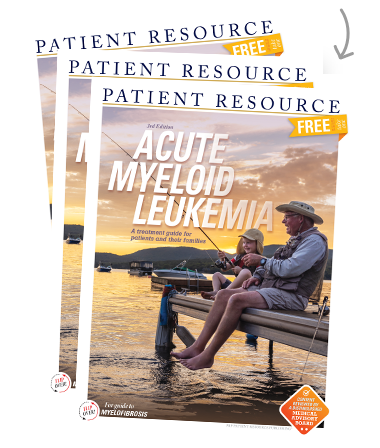Acute Myeloid Leukemia
Treatment Planning
Advances in treating acute myeloid leukemia (AML) are leading to improved quality of life and longer survival times. Many of these treatments target the unique chromosome and genetic abnormalities found in AML. Discuss your subtype with your doctor and ask about available treatment options.
Phases of Treatment
Every diagnosis is unique, but AML treatment generally begins quickly with two phases of chemotherapy: remission induction therapy and post-remission therapy.
The goal of remission induction therapy is to destroy the leukemia cells in the blood and bone marrow, putting the AML into complete remission. Complete remission is defined as having blood counts that are back to normal, the elimination of leukemia cells in blood and bone marrow samples that are examined under a microscope, and no signs or symptoms of the disease.
Post-remission therapy, also called consolidation therapy, is then started to kill remaining leukemia cells that could cause a relapse.
After additional test results are examined, your doctor will consider your age, general health, ability to manage certain therapies and your preferences for daily living. The following options may be used alone or in combination.
Chemotherapy kills cancer cells and some healthy cells. It may be used for remission induction therapy or post-remission therapy, or followed by stem cell transplantation. Many factors contribute to the choice of chemo- therapy drug that will be most effective for you, including your age (whether you are younger or older than 60), risk factors and prognosis (predicted outcome after treatment). Sometimes chemotherapy requires a lengthy hospital stay so blood counts can be closely managed. When AML has spread to the brain and spinal cord, intrathecal chemotherapy that is injected into the fluid-filled space between the thin layers of tissue that cover the brain and the spinal cord may be used.
Stem cell transplantation may be curative. An allogeneic transplant is most commonly used for AML. It involves stem cells donated by a family member or an unrelated donor. To reduce the risk of Graft-versus-Host Disease (GvHD), a serious condition in which transplanted donor immune cells attack the patient, it is important the patient’s and donor’s tissues match as closely as possible.
An allogeneic transplant can work directly against the cancer through the graft-versus-tumor effect (also referred to as graft-versus-leukemia or graft-versus-cancer-cell). This may occur when the donor’s white blood cells (the graft) attack any cancer cells (the tumor) remaining. The graft-versus-tumor effect can be key to a successful outcome.
The assistance of a caregiver post-transplant will be invaluable. Talk with your doctor about how a caregiver can help and for how long.
Targeted therapy uses drugs or other substances to identify and attack specific cancer cells. Targets include gene mutations, chromosome alterations and proteins on the cell surface. Targeted therapy is intended to affect only cancer cells. It may be given alone or in combination with chemotherapy, depending on the presence of certain gene mutations (alterations) or specific proteins on the surface of the leukemia cells. Some targeted therapies are approved to treat the CD33 protein and the FLT3 (pronounced “flit-three”), IDH1 and IDH2 gene mutations.
Radiation therapy uses high-energy radiation to destroy cancer cells. It may be used if the cancer has spread to the brain, spinal fluid or testicles. It may also be used to shrink a collection of leukemia cells that has formed a mass. Some people with localized disease (disease in a specific area of the body) or bone pain that does not lessen with chemotherapy may receive radiation therapy to specific parts of the body. Total body irradiation may be given to the entire body before stem cell transplantation to make space for the new cells (graft) to replace the diseased blood system.
Leukapheresis may be used temporarily to help immediately lower white blood cell counts when leukostasis occurs. Leukostasis is a very high number of leukemia cells in the blood that can affect normal blood circulation. During leukapheresis, blood is removed to eliminate leukemia cells and then the remaining blood is returned to the body.
Growth factors are sometimes given to increase the number of white blood cells that are decreased by treatment, which can increase the risk of infection. Growth factors may be given before stem cells are collected or after chemotherapy once remission is reached.
Clinical trials may be considered at any time. Many strategies are being researched, including new targeted therapies, immune therapies and combinations. In chimeric antigen receptor (CAR) T-cell therapy, for example, the patient’s T-cells are removed during remission, engineered to express a CAR that targets remaining AML cells, and infused back into the body.
Relapsed and Refractory AML
AML can become resistant at any time in the treatment process. This is called refractory AML. When it returns, it is called relapsed AML. In these cases, your doctor may perform new tests and recommend a new treatment plan.
|
Common Drug therapies for AML
These therapies may be used alone or in combination. |
| azacitidine (Vidaza) |
| azacitidine (oral) (Onureg) |
| cytarabine |
| daunorubicin hydrochloride |
| daunorubicin/cytarabine liposomal (Vyxeos) |
| doxorubicin hydrochloride (Adriamycin) |
| enasidenib (Idhifa) |
| gemtuzumab ozogamicin (Mylotarg) |
| gilteritinib (Xospata) |
| glasdegib (Daurismo) |
| ivosidenib (Tibsovo) |
| quizartinib (Vanflyta) |
| Possible Combination Therapies |
| ADE: cytarabine (Ara-C), daunorubicin hydrochloride, etoposide phosphate (Etopophos) |
| cytarabine with other approved anti-cancer drugs |
| glasdegib (Daurismo) with low-dose cytarabine |
| idarubicin (Idamycin, Idamycin PFS) with other approved anti-leukemic drugs |
| ivosidenib (Tibsovo) with azacitidine (Onureg) |
| midostaurin (Rydapt) with cytarabine and daunorubicin induction and cytarabine consolidation |
| quizartinib (Vanflyta) with cytarabine |
| quizartinib (Vanflyta) with cytarabine and anthracycline |
| venetoclax (Venclexta) with azacitidine (Vidaza) or decitabine (Dacogen) or low-dose cytarabine |



